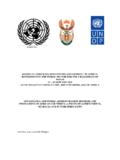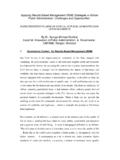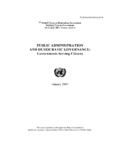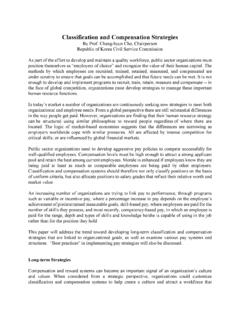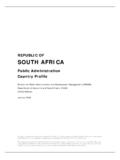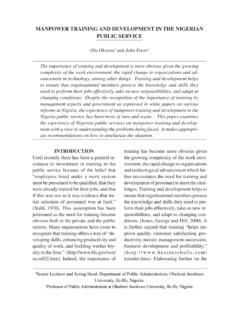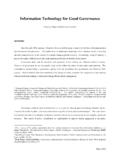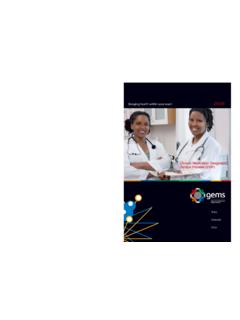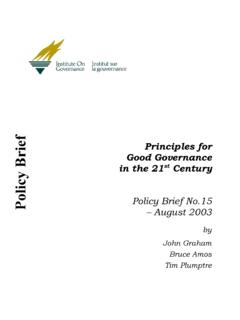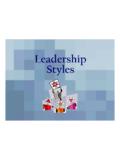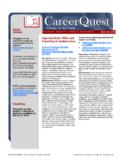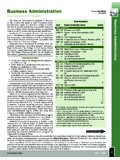Transcription of Key Challenges and Recommendations - United Nations
1 Human Resource Management (HRM)Marie-Fran oise BechtelKey Challenges and RecommendationsCEPA, 8th Session, New York, 30 March 20092 Table of Contents Definitions of HRM Main issues at stake in HRM Priorities of HRM Typology of HRM regimes Recommendations for the future Institutional mechanisms Managerial mechanisms (of HR, strictly speaking)3A definitionBroadly:Set of tools to(1)recruit employees, form and organise their professional careers, and (2)ensure that employees are assigned to do the adequate tasks and that the overall performance of the administration is aligned well with the general and particular objectives that it seeks to accomplish.
2 4A definitionSpecifically:Set of tools which makes it possible to undertake1)a search for the best possible assignment of people to the required tasks, and2)a search for the best possible service delivery given the human faculties that human resources are used most effectively with a view to bringing administrative performance which, unlike in the private sector, is not measurable in terms of profits or direct cost, but integrates the specific dimension of public service Which assumes linking: Crucial Issue6 Crucial Issue:Administrative PerformancePublic service as the unique dimension:Objectives soughtEvaluation of strengths and weaknessesof each administrationGeneralSpecificHow to make sure that public service is most effective and affordable?
3 Which public policies to prioritize and what immediate problems to resolve?To define priorities in improving the human resources 7 Evaluation of what should be the standard for good administration in method and application: competency(including efficiency), accountability(including integrity), transparency(ranging from the legitimacy of acts of the administration to civic participation), sense of public interest(which includes the fair handling of users) .Crucial Issue: What is the benchmark?8 Priorities in the Field of Human Resources (HR)Cost / Performance link:Weight of the administration in the GNPM otivation of employees to participateto the making of new public policiesInitial developmentCreating the conditions for a competent administration Making public service jobs attractivePreventing the brain drainDeveloped countriesCountries in transitionCountries with weak administration9 Principal HRM Issues at Stake.
4 A TypologyDecentralisedCentralisedLinked to government(nominations of political nature)Independent of governmentFounded on special skillsFounded on general skillsNot founded on initial meritsFounded on initial meritsRegime typeRegime typeCrucial problems to resolveCrucial problems to resolvewithoutRecruitmentEmploymentAuton omyStructureStaff MobilityDrain to the private sector (PS M/S)organisedcareerwithLeadership et independence (HPS)Promotion criteriaProfessionalising the staff with general skillsDifficulties related to mobility &Narrow competency fieldsAdministrative strength (HA) &Lack of accountability and transparency of agentsLack of impartiality and clientelismAbsence of transparencyCorruption and/or particularistic local interestsPS M/S: Middle-and high- level public servants HPS: High- level public servantsHA.
5 High administration10 HRM RegimesInstitutional MechanismsManagerial MechanismsHuman factor in public administrationGeneral RecommendationsCentral toolin charge of HRSeparate control agencies Internal promotion mechanismsLeading tools for provisional managementBodies of employee participationCharter/ public service contract Participation of employees/ usersAccountability of higher management Continuous education of all category of employees*professionalising*openness and mobility*(professional) ethics11 Institutional Mechanisms1.
6 Central tool in charge of HR at the global level: for career management in order to ensure satisfactory mobility, regardless of the recruitment mode at the level of any given service: in order to ensure the right allocation of employees to posts, their motivation and performance with coordination among all administrative entities: (for instance, regular meetings of HRM managers at each ministry or local administrative body). 12 Institutional Mechanisms2. Separate agencies in charge of control: respect for accounting and financial rules, overall workings of the agency, employee evaluation (staff performance), disciplinary Internal promotion mechanisms, regardless of the mode of employee recruitment13 Institutional Mechanisms4.
7 Leading tools for the provisional management of posts according to: demographics in public service, and administrative needsshort-term (case of reconstruction) medium-term(new Challenges : environment security, sanitary control, and of course, development policies: infrastructure, health, education) 5. Bodies of employee participation in the organisation and workings of the department14 Managerial Mechanisms1. Establishing a charter or a service contract in each administrative agency in order to ensure the motivation, recognition of merit, capacity of teamwork, effective ties with the Encouraging employee participation in the definition of the charter; and user participation, whenever possible.
8 15 Managerial Mechanisms3. Accountability of higher management on whom depends the implementation of the charter: foreseeing that the evaluation of higher management includes their capacity to advance the implementation of the objectives of the charter / service contract ; planning regular meetings of chiefs of agencies on good practices and increasing their familiarity with comparative studies (foreign problems and practices).16 Managerial Mechanisms4. Organising the continuous education of all categories of employees with a view to ensuring professionalisation (NTIC, for instance) openness and mobility balance between continuity of administrative action and its capacity to confront change, and professional ethics in public service17 THANK YOU
